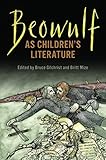Beowulf as Children’s Literature / ed. by Britt Mize, Bruce Gilchrist.
Material type: TextPublisher: Toronto : University of Toronto Press, [2021]Copyright date: 2021Description: 1 online resource (328 p.) : 27 b&w illustrationsContent type:
TextPublisher: Toronto : University of Toronto Press, [2021]Copyright date: 2021Description: 1 online resource (328 p.) : 27 b&w illustrationsContent type: - 9781487502706
- 9781487515843
- Children -- Books and reading -- History
- Children's literature -- History and criticism
- LITERARY CRITICISM / Children's & Young Adult Literature
- Beowulf
- Grendel
- Old English literature
- Old English poetry
- Tolkien
- adaptation
- children’s literature
- history of children’s literature
- medieval literature
- picture books
- storybooks
- translation
- 829/.3 23
- online - DeGruyter
| Item type | Current library | Call number | URL | Status | Notes | Barcode | |
|---|---|---|---|---|---|---|---|
 eBook
eBook
|
Biblioteca "Angelicum" Pont. Univ. S.Tommaso d'Aquino Nuvola online | online - DeGruyter (Browse shelf(Opens below)) | Online access | Not for loan (Accesso limitato) | Accesso per gli utenti autorizzati / Access for authorized users | (dgr)9781487515843 |
Frontmatter -- Contents -- Illustrations -- Acknowledgments -- Introduction: Beowulf in and near Children’s Literature -- 1. “A Little Shared Homer for England and the North”: The First Beowulf for Young Readers -- 2. The Adaptational Character of the Earliest Beowulf for English Children: E.L. Hervey’s “The Fight with the Ogre” -- 3. Tolkien, Beowulf, and Faërie: Adaptations for Readers Aged “Six to Sixty” -- 4. Treatments of Beowulf as a Source in Mid-Twentieth-Century Children’s Literature -- 5. Visualizing Femininity in Children’s and Illustrated Versions of Beowulf -- 6. What We See in the Grendel Cave: Manipulations of Perspective in Beowulf for Children -- 7. Beowulf, Bèi’àowǔfǔ, and the Social Hero -- 8. The Monsters and the Animals: Theriocentric Beowulfs -- 9. Children’s Beowulfs for the New Tolkien Generation -- 10. The Practice of Adapting Beowulf for Younger Readers: A Conversation with Rebecca Barnhouse and James Rumford -- 11. Children’s Versions of Beowulf: A Bibliography -- Index
restricted access online access with authorization star
http://purl.org/coar/access_right/c_16ec
The single largest category of Beowulf representation and adaptation, outside of direct translation of the poem, is children’s literature. Over the past century and a half, more than 150 new versions of Beowulf directed to child and teen audiences have appeared, in English and in many other languages. In this collection of original essays, Bruce Gilchrist and Britt Mize examine the history and processes of remaking Beowulf for young readers. Inventive in their manipulations of story, tone, and genre, these adaptations require their authors to make countless decisions about what to include, exclude, emphasize, de-emphasize, and adjust. This volume considers the many forms of children’s literature, focusing primarily on picture books, illustrated storybooks, and youth novels, but taking account also of curricular aids, illustrated full translations of the poem, and songs. Contributors address issues of gender, historical context, war and violence, techniques of narration, education, and nationalism, investigating both the historical and theoretical dimensions of bringing Beowulf to child audiences.
Mode of access: Internet via World Wide Web.
In English.
Description based on online resource; title from PDF title page (publisher's Web site, viewed 19. Oct 2024)


